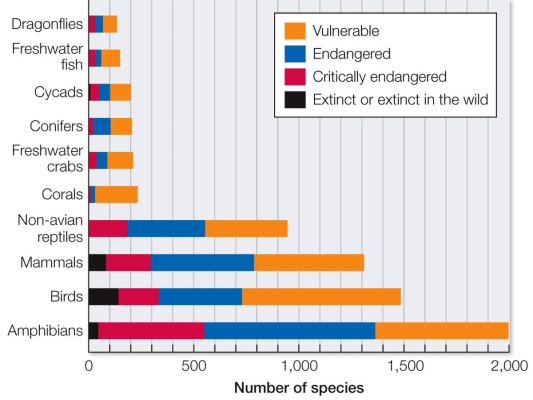Refer to the graph.  So far, the IUCN has assessed more than 76,000 species, but there are at least 8.7 million species on Earth (probably more) , and most of them are invertebrates.Few plants and invertebrates have been assessed.Their list of at-risk organisms is heavily skewed toward vertebrates, which are larger and easier to measure.Given this knowledge, what is the most reasonable conclusion that can be drawn regarding the at-risk groups shown on the graph?
So far, the IUCN has assessed more than 76,000 species, but there are at least 8.7 million species on Earth (probably more) , and most of them are invertebrates.Few plants and invertebrates have been assessed.Their list of at-risk organisms is heavily skewed toward vertebrates, which are larger and easier to measure.Given this knowledge, what is the most reasonable conclusion that can be drawn regarding the at-risk groups shown on the graph?
A) Of the species assessed, amphibians have by far the most species at risk.
B) Of the species assessed, most are likely to go extinct eventually.
C) Most dragonfly and other insect species are not at risk.
D) Vertebrates are most at risk because they are the most important organisms.
E) Even after new species are assessed, few plant species will be at risk.
Correct Answer:
Verified
Q127: The government must assess a species' extinction
Q128: The population of the California red-legged frog
Q129: Tropical evergreen forests might be especially vulnerable
Q130: Which of these populations is least likely
Q131: Because giraffes are large and relatively friendly,
Q133: The Amur leopard now lives only in
Q134: Ninety percent of a forest is cut
Q135: Plume hunting in the late 1800s to
Q136: The wood thrush is a forest interior
Q137: Leatherback turtles occur in the Atlantic, Pacific,
Unlock this Answer For Free Now!
View this answer and more for free by performing one of the following actions

Scan the QR code to install the App and get 2 free unlocks

Unlock quizzes for free by uploading documents